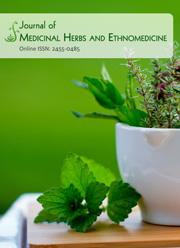Microscopical characters, phytochemical, and antioxidant screening of hydroalcoholic extract of Solanum xanthocarpum and Mentha arvensis
Abstract
Mentha arvensis belonging to the family of Lamiaceae, originally the plant was imported from Japan and is
therefore also known as Japanese Mint. The plant is a common garden herb and is extensively cultivated in
Northern India for food seasoning as a household remedy and for its industrial used. The Solanum xanthocarpum is
popularly known as Kateli, Kandakarichunda, Kandankattiri, and Indian Solanum. It has sharp and prickly branches
that are densely covered with rather a minute star shaped hair. The sparsely hairy egg-shaped leaves, purple
colored flowers, and round fruits. The fruit also has smooth seeds. The aim of the present study was microscopic
characters of M. arvensis and S. xanthocarpum leaves, hydroalcoholic extract of the both leaves was used to
qualitative screening analyses by color reaction-based identification of active constituents, to determine the total
phenolic content, flavonoid content, and antioxidant potential by di-phenyl picrylhydrazyl method.



 .
.